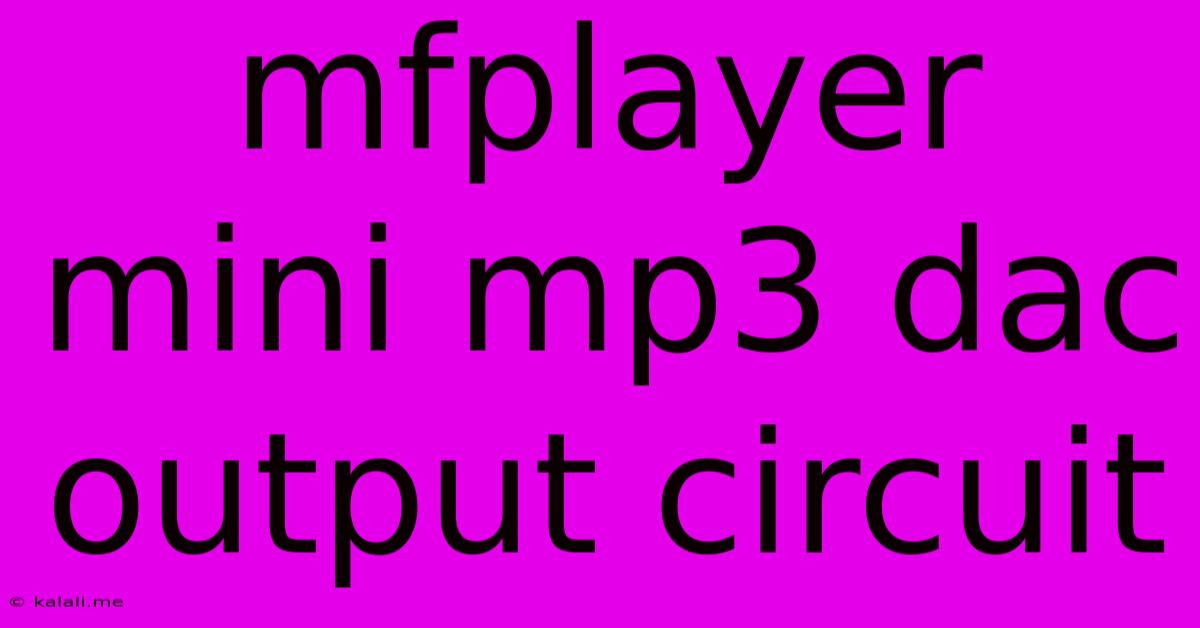Mfplayer Mini Mp3 Dac Output Circuit
Kalali
May 24, 2025 · 3 min read

Table of Contents
MFPlayer Mini MP3 DAC Output Circuit Explained: A Deep Dive
This article dives deep into the output circuit of the MFPlayer Mini MP3 module, a popular and affordable choice for audio projects. Understanding this circuit is crucial for optimizing audio quality and troubleshooting potential issues. We'll explore its components, their functions, and how they contribute to the overall audio output. This information is valuable for hobbyists, makers, and anyone looking to improve their MP3 playback experience using the MFPlayer Mini.
The MFPlayer Mini uses a digital-to-analog converter (DAC) to transform the digital audio data into an analog signal suitable for driving headphones or speakers. The output circuit then shapes and amplifies this signal. Let's break down the key components:
Understanding the Core Components
1. The DAC Chip
The heart of the output lies within the integrated DAC chip embedded within the MFPlayer Mini. This chip performs the critical conversion from digital audio (like MP3) to an analog voltage signal representing the audio waveform. The specific DAC chip used varies depending on the MFPlayer Mini version, but generally, these are low-power, cost-effective chips designed for applications like this. The specifications of this chip directly impact the audio quality, with factors like bit depth and sample rate playing significant roles.
2. Output Buffer Amplifier
Following the DAC, a buffer amplifier plays a crucial role. Its primary function is to isolate the DAC from the load (your headphones or speakers). This is essential because the DAC chip is often a high-impedance output and can be easily affected by the load's impedance. The buffer amplifier provides a low impedance output, resulting in cleaner audio and preventing signal distortion, especially when driving low-impedance headphones. It also helps to increase the output voltage swing, providing a louder and more powerful signal.
3. Output Capacitor(s)
Capacitors are often included in the output stage for filtering. These capacitors typically block any DC component present in the output signal, ensuring that only the AC audio signal reaches your headphones or speakers. A DC component could potentially damage your speakers or introduce unwanted noise into the audio. The capacitor value(s) affect the low-frequency response.
4. Output Connector
Finally, the output connector acts as the interface between the circuit and your external audio device. This connector could be a standard 3.5mm headphone jack, a set of RCA connectors, or another type depending on the specific MFPlayer Mini board design. The quality of this connector, and its wiring, can influence the overall signal integrity.
Troubleshooting Common Issues
Understanding the MFPlayer Mini's output circuit helps troubleshoot common problems:
- Low Volume: Check the volume settings on both the MFPlayer Mini and your external device. A faulty buffer amplifier or a low-quality output connector could also contribute to low volume.
- Distorted Audio: This is frequently due to an overloaded output stage, which might happen when driving low-impedance speakers or headphones without sufficient amplification. The buffer amplifier's capabilities should be considered in relation to the load.
- Noise/Hum: Poor grounding, a faulty capacitor, or interference from other electrical components could introduce noise or hum. Checking connections and ensuring proper grounding are critical steps in troubleshooting.
Optimizing Audio Performance
While the MFPlayer Mini's stock output circuit is functional, certain improvements can enhance audio quality:
- High-Quality External Amplifier: Using an external amplifier after the MFPlayer Mini provides significant improvement. It can boost the signal, reduce noise and distortion, and tailor the sound to your specific needs.
- Better Capacitors: Upgrading output capacitors to higher-quality components with better tolerance can refine the frequency response.
By understanding the MFPlayer Mini MP3 DAC output circuit, you can troubleshoot problems effectively and even implement improvements for a more satisfying listening experience. Remember to always handle electronic components with care and observe proper safety precautions when working with circuits.
Latest Posts
Latest Posts
-
How To Remove A Bathroom Faucet
May 24, 2025
-
How Do I Stop Birds From Flying Into My Windows
May 24, 2025
-
How To Tell If A Propane Tank Is Empty
May 24, 2025
-
Shake Off The Dust Of Your Feet
May 24, 2025
-
How To Get Small Dents Out Of Car
May 24, 2025
Related Post
Thank you for visiting our website which covers about Mfplayer Mini Mp3 Dac Output Circuit . We hope the information provided has been useful to you. Feel free to contact us if you have any questions or need further assistance. See you next time and don't miss to bookmark.